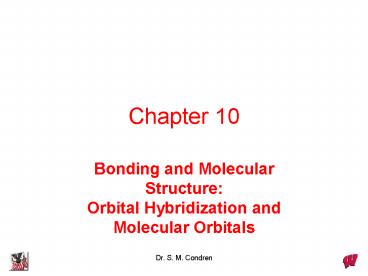Bonding and Molecular Structure: Orbital Hybridization and Molecular Orbitals - PowerPoint PPT Presentation
1 / 37
Title:
Bonding and Molecular Structure: Orbital Hybridization and Molecular Orbitals
Description:
Chapter 10 Bonding and Molecular Structure: Orbital Hybridization and Molecular Orbitals Two Theories of Bonding MOLECULAR ORBITAL THEORY Robert Mullikan (1896 ... – PowerPoint PPT presentation
Number of Views:250
Avg rating:3.0/5.0
Title: Bonding and Molecular Structure: Orbital Hybridization and Molecular Orbitals
1
Chapter 10
- Bonding and Molecular StructureOrbital
Hybridization and Molecular Orbitals
2
Advanced Theories of Chemical Bonding
Atomic Orbitals
Molecules
3
Two Theories of Bonding
- MOLECULAR ORBITAL THEORY
- Robert Mullikan (1896-1986)
- valence electrons are delocalized
- valence electrons are in orbitals (called
molecular orbitals) spread over entire molecule.
4
Two Theories of Bonding
- VALENCE BOND THEORY Linus Pauling
- valence electrons are localized between atoms (or
are lone pairs). - half-filled atomic orbitals overlap to form bonds.
5
Sigma Bond Formation by Orbital Overlap
Two s orbitals overlap
6
Sigma Bond Formation
Two s orbitals overlap
One s and one p orbital overlap
Two p orbitals overlap
7
Using VB Theory
- Bonding in BF3
planar triangle angle 120o
8
Bonding in BF3
- How to account for 3 bonds 120o apart using a
spherical s orbital and p orbitals that are 90o
apart? - Pauling said to modify VB approach with ORBITAL
HYBRIDIZATION - mix available orbitals to form a new set of
orbitals HYBRID ORBITALS that will give the
maximum overlap, in the correct geometry.
9
Bonding in BF3
10
Bonding in BF3
- The three hybrid orbitals are made from 1 s
orbital and 2 p orbitals ? 3 sp2 hybrids.
- Now we have 3, half-filled HYBRID orbitals that
can be used to form B-F sigma bonds.
11
Bonding in BF3
An orbital from each F overlaps one of the sp2
hybrids to form a B-F ? bond.
12
BF3, Planar Trigonal
13
Bonding in CH4
- How do we account for 4 CH sigma bonds 109o
apart? - Need to use 4 atomic orbitals s, px, py, and pz
to form 4 new hybrid orbitals pointing in the
correct direction.
14
Bonding in CH4
15
Bonding in a Tetrahedron Formation of Hybrid
Atomic Orbitals
- 4 C atomic orbitals hybridize to form four
equivalent sp3 hybrid atomic orbitals.
16
(No Transcript)
17
Bonding in Glycine
18
Orbital Hybridization
- BONDS SHAPE HYBRID REMAIN
- 2 linear sp 2 ps
- 3 trigonal sp2 1 p planar
- 4 tetrahedral sp3 none
19
Multiple Bonds
- Consider ethylene, C2H4
20
Sigma Bonds in C2H4
21
p Bonding in C2H4
- The unused p orbital on each C atom contains an
electron and this p orbital overlaps the p
orbital on the neighboring atom to form the p
bond.
22
p Bonding in C2H4
- The unused p orbital on each C atom contains an
electron and this p orbital overlaps the p
orbital on the neighboring atom to form the p
bond.
23
Multiple Bondingin C2H4
24
s and p Bonding in C2H4
25
s and p Bonding in CH2O
26
s and p Bonding in C2H2
27
s and p Bonding in C2H2
28
Consequences of Multiple Bonding
There is restricted rotation around CC bond.
29
Consequences of Multiple Bonding
Restricted rotation around CC bond.
30
Diatomic Molecules
- AO MO AO
- H H2 H
1s
1s
ENERGY
B gt bonding electrons
B - AB 2 - 0 B.O.
------------ -------- 1
2 2
AB gt antibonding electrons
all electrons are paired, thus diamagnetic
31
Diatomic Molecules
- AO MO AO
- He He2 He
1s
1s
ENERGY
Zero bond order means it does not exist
B - AB 2 - 2 B.O.
------------ -------- 0
2 2
32
Diatomic Molecules
- AO MO AO
- He He2 He
1s
1s
ENERGY
B - AB 2 - 1 B.O.
------------ -------- 1/2
2 2
One unpaired electron, thus, paramagnetic
33
AO B
AO B
MO B2
2p
2p
2s
2s
1s
1s
nonbonding
34
Molecular Orbital Diagram
antibonding MO
end-to-end
bonding MO
antibonding MO
side-by-side
bonding MO
35
AO C
AO C
MO C2
2p
2p
2s
2s
1s
1s
nonbonding
36
AO O
AO O
MO O2
2p
2p
2s
2s
1s
1s
nonbonding
37
Energy































